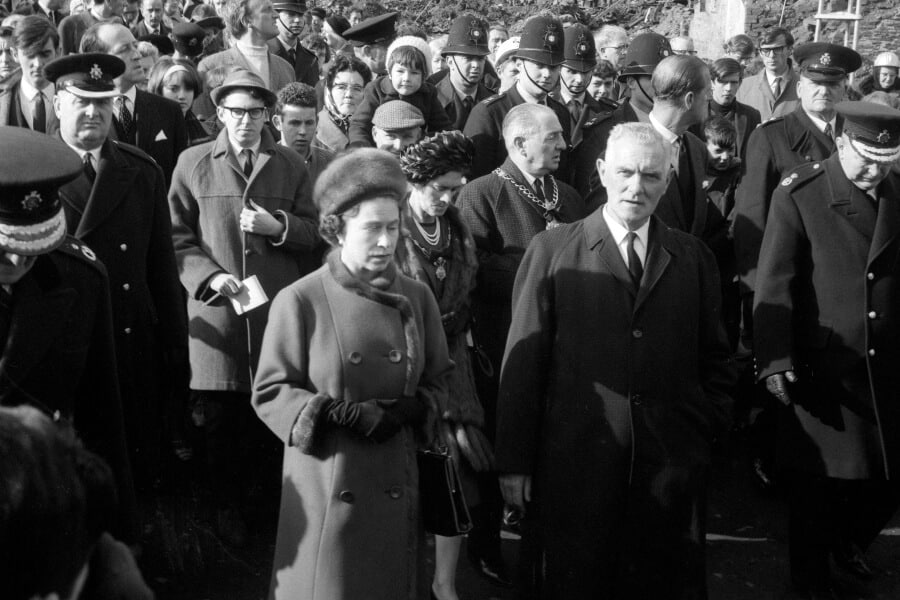On October 21, 1966, Queen Elizabeth was 40 years old. Her one son, Prince Charles, was 18. I was 17 years old. As I was leaving for school that morning, I heard on the news of the terrible disaster in a small Welsh town called Aberfan. “An old mining tip, a mixture of slurry and water, had collapsed on Pantglas Junior School, a primary school killing 116 children, while they were doing their morning ABCs, five teachers, and 28 adults from the school and neighboring row houses also died,” the announcer said.
Knowing him somehow made the tragedy all the more real for me.
I knew about Wales because a family friend had recently visited us from Cardiff, the capital. Knowing him somehow made the tragedy all the more real for me. I ran to my atlas and found that Aberfan was a small village, near Merthyr Tydfil at the base of the Rhonda Valley, coal mining country. I became obsessed by the disaster and followed the news of it through the coming months. It turned out that the 111-feet-high tip was one of seven created in 1958. After years of rain, it had come to the villagers notice that there was water gathering under the tip. In fact it turned out to be a natural spring.
In the fall of 1966, Aberfan got a lot of rain and there were complaints as the spring began to flood with the continuous rainfall. With 6.5 inches of rain, the waters were black and muddy and had a greasy residue. The villagers banded together to try and convince the National Coal Board to move the tip. But they were ignored.
Read More: The Amazing Exploits of a Female WWII Spy
The Terrible Day
The avalanche on that October morning brought down thick mud and rubble, which broke through the classroom windows and pushed down the doors. The noise of 30 feet of slurry and waste material moving was likened to a roaring train. Those children and teachers caught in it were buried alive. Those who survived were dug out and brought by ambulance to East Glamorgan General Hospital. There were no survivors found after 11:00 a.m. that morning.
Not going to Aberfan sooner was the single biggest regret of the Queen’s regime.
That day and night, thousands of volunteers came from around Great Britain and the world to help dig. I watched some of this on the evening news. There was incredible noise and confusion and continuing rain. I later learned that the Queen was advised by her secretary not to go to Aberfan immediately; so she waited. It wasn’t till a week later that she went. Afterward she said she should have gone sooner, and it was the single biggest regret of her regime.
When I interviewed a few survivors years later, they all felt strongly that the Queen’s waiting had been the right move. None of them would have been able to accept her comfort at that terrible time. Each of them felt her care and empathy deeply when she did come, and on her subsequent visits: after the community garden had been planted, on the 20th anniversary, on the day the new school opened, and on the 50th anniversary of the disaster. It seemed to me that she always came as a mother, not as the Queen.
A Personal Connection
In 1967, I was still gripped by the aftermath of the Aberfan disaster, reading everything I could get my hands on regarding the Tribunal that concluded its hearings in late April 1967 and published a report blaming the disaster mostly on the National Coal Board.
In 1969, I spent the summer working for a large company with offices in London and a manufacturing facility in South Wales. When I visited the factory I drove up through Aberfan, and fell in love with the lush greenery of the valley. On that visit, I had a quick drink in a local pub and happened on the weekly practice of the men’s choir. The men singing acapella brought me to tears. It turned out that many of them had lost children in the disaster.
One young girl’s face stayed with me. Years later, I found the girl.
In 1970, I fell in love and began living in Caerphilly, Wales. I had the opportunity to spend time in Aberfan. I’d had a dream about a group of kids who had survived and had started a kind of club where they talked about their fears since the disaster, a kind of grief group. I began to put pencil to paper and wrote a first draft of a novel for young adults with those kids as characters. It didn’t work at all; the voices were all wrong. I put the manuscript aside.
Years passed and coincidently, I met a photographer who had arrived in Aberfan the day after the disaster and who had photographed the actual aftermath, and took close-ups of the volunteers and parents. These photos were riveting and gave me an inside look at the disaster. One young girl’s face stayed with me. Years later, I found the girl and we spoke about her continued PTSD and how she had suffered through the years.
Writing the Book on Aberfan
I knew I was dealing with such sacred material I was almost afraid to touch it. The loss in the community was so great and the people continued to feel it. I was an outsider, how could I ever write about such a huge loss?
But I continued to go back to Aberfan again and again. I walked among the graves of the children buried on the hillside under white arches and read what parents had written on their headstones.
When I lost my second husband, my fictional story about Aberfan came alive for me.
Years after I left Wales and my first marriage, I suffered my own terrible tragedy. When I lost my second husband, my fictional story about Aberfan came alive for me. The young girl I had met in Aberfan became the essence of Alys, my main protagonist, and the time I’d spent in Aberfan and the people I had met, allowed me to invent other characters. Perhaps I had been stumped because I hadn’t yet felt my own deep sorrow of a loss.
My book, Digging Out, was published in 2004. For sure, I was digging out, and so were the characters in my book. It’s what we do after a tragedy. Grief is a continuing challenge and one that shows itself again and again.
Fifty-six years later, Aberfan is still in my consciousness.
The death of the Queen brings it all full circle for me. Her relationship with the people of Aberfan continued to be close until her death. The Queen never let the villagers down.
Read More: Gerty Simon: A Pioneering Photographer Who Reinvented Herself to Survive the Nazis
Katherine Leiner has written a new novel, Bird on a Wire, and is looking for a publisher.





















0 Comments